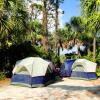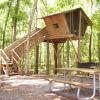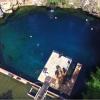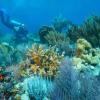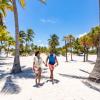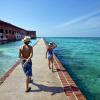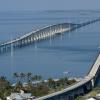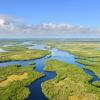The Great Calusa Blueway, a 190-mile saltwater paddle trail that weaves its way along the mangrove islands and sugar-sand beaches of the Fort Myers area, promises world-class fishing and birdwatching, remote sites for a romantic picnic or camping and a veritable playground for geocachers.
Paddlers of all experience levels, including those who have never held a paddle, can choose a trail and explore the unspoiled beauty, history and abundant natural habitats along the Great Calusa Blueway.
Read on to discover more about the trail and how you can enjoy it.
Mysterious, Magical Three
The Calusa Indians, Florida’s first fishermen and shell collectors, were known as the “water people,” living off the bounty of the Gulf of Mexico and building cities and even islands from shells.
The Calusa spiritual beliefs centered on the number three, and fittingly, so does the pathway to exploring these waters today, as The Blueway is divided into three sections: Estero Bay, Pine Island Sound and the Caloosahatchee River, each with its own appeal.
Estero Bay: Dolphins, Shell Mounds and Kicked-Back Luxury
Starting in the Fort Myers Beach area and south to Bonita Springs, the first segment of the Great Calusa Blueway centers on Estero Bay, where there are plentiful stops along mangrove-laced keys to view shore birds catching a meal. It’s common to encounter a group of playful dolphins or inquisitive manatees in these shallow waters. Here, you’ll paddle through open water sheltered by small keys and along twisted mangrove pathways.
You can get a fascinating glimpse of the Calusa civilization at Mound Key Archaeological State Park, an island accessible only by kayak or private boat. This storied location once served as the capital city of the mighty Calusa, who ruled south Florida until the 1600s when Spanish explorers arrived, eventually wiping the natives with war and disease. Mound Key was also the site of a Spanish fort and the first Jesuit mission in the New World.
A self-guided trail on the island describes how the complex, ingenious Calusa lived, building shelters, burial mounds and even islands of shells, as well as canals and dugout canoes for traveling the waterways. If paddling with a local guide in this area, you’re likely to hear riveting stories of Calusa and Spanish encounters.
As you stand on top of the 31-foot-high shell midden at the mouth of the Estero River, you can still see evidence of the intricate system of canals that allowed the Calusa to pull their dugout canoes right up to their thatched huts.
Paddlers typically launch from Koreshan State Park or Lovers Key State Park to access the park.
When it’s time to recharge your batteries, you’ll be happy to know Estero Bay offers more than cultural and natural wonders. You can paddle over to the Pink Shell Beach Resort and Spa, Hyatt Regency Coconut Point Resort & Spa or Flippers on the Bay for a cool drink or luscious fare.
Pine Island Sound: Mangrove Tunnels, Beach Camping and Fabulous Fishing
Just north of Fort Myers Beach along Pine Island Sound, the second segment of the Great Calusa Blueway flows along Pine Island, reaching west to the barrier islands of Sanibel and Captiva. From open water to tidal creeks, and the protected waters within the J.N. “Ding” Darling National Wildlife Refuge on Sanibel Island, this area is reminiscent of the Everglades or Ten Thousand Islands.
Adventurers will be intrigued by the tangled mangrove tunnels of Pine Island Sound Aquatic Preserve and Matlacha Pass Aquatic Preserve. Simply paddle into an opening to discover a path and see if it loops, dead ends or winds into a salt water lagoon.
Campers can fall asleep to the sound of the surf at Cayo Costa State Park, a remote, sugar-sand barrier island, either at its tent sites or in rugged cabins. For primitive campsites, paddle to Picnic Island on the trail’s south end, a haven for kayakers on overnighters.
Paddle to the Pineland Historical Marker and take a stroll across the street to the Randell Research Center to enjoy a self-guided tour that provides a view from atop a shell midden overlooking all of Pine Island Sound.
Anglers take note: the fishing is legendary. Field & Stream magazine included ‘Pine Island Coast’ as one of "America's 25 hottest fishing spots,” citing its lush scenery as well as its fishing, ideally suited to kayaks that can access shallow, narrow areas that other boats can’t navigate. You may catch snook, redfish, trout, and even sharks and tarpon.
The Caloosahatchee River: Tributaries and Trails
You won’t believe you’re paddling in a county with over a half-million residents on the peaceful Caloosahatchee River, the third and newest segment of the Great Calusa Blueway. The River was a main waterway for the Calusa natives, as well as early Fort Myers settlers, and powerboats and sailboats still employ the route.
But the 38 miles that the River flows, from its mouth east to the Hendry-Lee county line, is just the beginning of offerings for paddlers. Creeks and feeder rivers promise a whopping 52 miles more, perfect for kayakers and canoeists to investigate.
While the Phase 1/Estero Bay and Phase 2/Pine Island Sound segments of the Blueway have trail markers, the Phase 3 section uses GPS coordinates for the mouth of each tributary instead.
Highlights of the trail include 765-acre Caloosahatchee Regional Park in historic Alva, offering camping, horseback riding and mountain biking trails as well as a kayak area with a day dock. Search the sand in the shallows along the shore on a treasure hunt for fossilized shark teeth.
A gentle current makes travel simple coming and going on the Orange River. In the winter, at the river’s mouth and just upstream near the power plant, you’ll find manatees, huge, gentle sea cows that gather in the waters to stay warm and feed.
Caloosahatchee Creeks Preserve is ideal for inexperienced paddlers. You launch from North Fort Myers into a labyrinth of creeks; you can circle around and arrive back to your starting point within the hour and never even venture into the much-wider Caloosahatchee.
For a kayaking trip you’ll always remember, take a sunset, full moon journey with GAEA Guides. You’ll watch the sun setting over the water in vivid hues, the moon rising in its perfect, round glory, and visit a bird rookery that’s home to thousands of birds.
The Spirit of the Calusa
With so much water to explore, the Great Calusa Blueway offers visitors an opportunity to experience its natural beauty and enjoy fishing, bird watching and surprise sightings of the amazing marine life that makes the waterways home. As you dip your paddle and glide silently through these waters, you too may feel the spirit of the Calusa.
When you go…
You can download trail maps detailing its three segments, discover tops spots along the trail, get recommendations from experienced paddlers, and find access points, outfitters, tours and rentals at www.calusablueway.com/ . Or, use your smart phone and download the free app at the iTunes store. Then, just pack a lunch, some sunscreen and a life jacket and you'll be ready to go.
To plan your trip, go to Fort Myers – Islands, Beaches and Neighborhoods.
PLACES TO REMEMBER
RELATED CONTENT
Great Hiking Trails in Florida
- 10 minute read
By Lauren Tjaden With varied terrain and tremendous ecological diversity, Florida provides hikers of every skill level a perfect backdrop for exercise...
10 Florida Trails You Need to Experience
- 5 minute read
Want to experience the splendor of greenways and trails? Florida's your place. Outdoor enthusiasts are encouraged to step off of the beaten path...
10 Reasons to Visit the Stephen Foster Folk Culture Center State Park
- 3 minute read
I enjoyed my recent visit to the Stephen Foster Folk Culture Center State Park in White Springs. This park is definitely "off the beaten...


